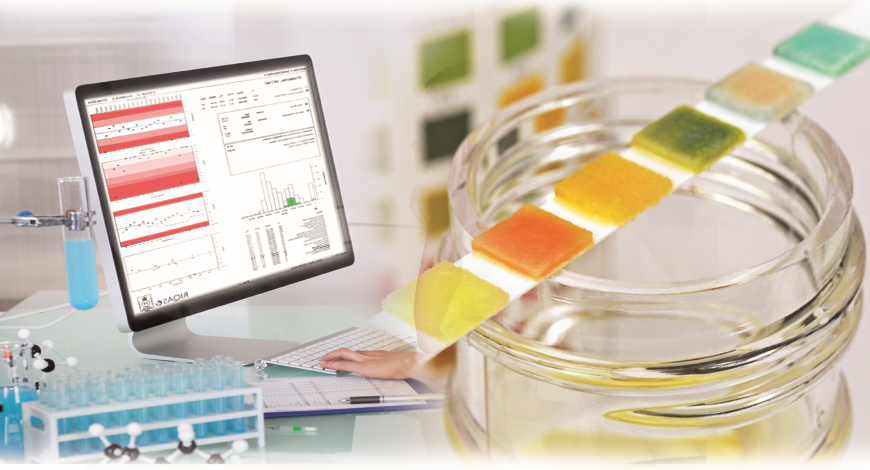Urinalysis Instruments and Reagents
Automation Drives Urinalysis Industry

Automating urine microscopy, simplifying workflow, and improving standardization through strip pads and digital and home-based tests continue to be the prime objectives in the coming years.
The essentiality of urinalysis as a crucial screening tool in the diagnosis of kidney and liver abnormality and urinary tract infections cannot be underestimated. Visual microscopic sediment analysis remains the foremost and primary standard for urine examination. However, basic urine tests continue to be a standout amongst the most ubiquitously requested tests. Labs are compelled to deliver precise and valid outcomes that provide clinical incentive to the doctor, all while reducing turnaround time with less staff and budgetary constraints. Decreasing repayments, expanded test use, and managed clinical quality measurements add to the pressure of lessening clinical research center test volumes and spending plans while expanding quality-confirmation checking and documentation. In view of the challenges faced by labs, solutions are required to streamline work process and diminish the work-escalated manual procedures of conventional urinalysis strategies while incorporating technological innovations in a cost-effective way to give an edge to the urinalysis instruments and reagents market.
Indian market
The Indian market for urinalysis analyzers and reagents in 2018 is estimated at Rs 172.6 crore. Reagents continue to dominate with an 81-percent share, valued at Rs 139 crore. The reagents may be further segmented as 75.5 percent being used by semi-automated instruments, catered to largely by Dirui and Transasia, and also by Roche and Siemens and 24.5 percent by fully automated ones catered to largely by Sysmex, Iris, and Dirui (Rapid).
Market – 2018* |
|
|---|---|
| Segment | Brand |
| Urine Chemistry | Dirui, Siemens, Roche, and Horiba |
| Urine Sediments | Sysmex, Iris (includes Beckman Coulter), Dirui, Roche, and URIT |
| Integrated Instruments | Iris (includes Beckman Coulter), Sysmex, Dirui, Roche, and URIT |
| Small Players | Mission (Peerless) and Teco Diagnostics |
Market – 2018* |
||||
|---|---|---|---|---|
| Tier I | Tier II | Tier III | ||
| Dirui | Transasia | Roche, Siemens, Agappe, Alere, and DiaSys | ||
Market – 2018* |
||||
|---|---|---|---|---|
| Segment | Tier I | Tier II | ||
| Reagents for FA | Sysmex, Iris, and Dirui (Rapid) | – | ||
| Reagents for SA | Dirui and Transasia | Roche and Siemens | ||
| ADI Media Research | ||||
The overall market has seen an increase in all segments, albeit there is a very slow transition to fully automatic analyzers, which are almost 95 percent placed. The semi-automatic instruments are also now increasingly being placed, with major revenue anticipated from reagents. The urinalysis market continues to be dominated by semi-automated instruments with a 97-percent share, by volume. However, the customers opt for high-throughput instruments.
The fully automated analyzers segment is estimated at Rs 15.6 crore, with integrated analyzers seeing maximum growth. The urine sediments fully automated instruments and urine chemistry instruments each contribute about 16 percent to the market, by value. By quantity, urine chemistry instruments have a 28.5 percent share, and urine sediments instruments a 21.43 percent. The integrated fully automated instruments are the most popular with a 50 percent share by quantity, albeit the share by value is 67.3 percent.
Global Market
The global urinalysis instruments and reagents market is estimated at USD 2.14 billion by 2022. Globally, the market is predicted to grow at a CAGR of 7.5 percent over the next 3 years, providing numerous opportunities for players to invest in research and development in the market.
The consumables segment dominated in 2019. Pregnancy and fertility kits accounted for the largest share of this market in 2019. These kits have witnessed wide adoption amongst end users across the globe owing to their cost-effectiveness and ease of use.
In 2019, the disease-screening segment accounted for the largest market share as urine analysis came to be included in the general check-up in hospitals and clinics. Pregnancy and fertility testing is carried out using the kits available in the market either in home care settings or in clinics.
The urinalysis market in North America is expected to grow at a rapid pace in the coming years. Increasing research activities in the field of urinalysis and growing awareness of personalized medicine has resulted in the establishment of point-of-care systems. Automated devices have been installed in large hospitals and laboratories.
The market is seeing increasing demand for urinalysis with unmet clinical needs in the under-developed regions across the globe. Factors in charge of bolstering the rise of urinalysis industry incorporate presentation of highly advanced diagnostic tools, expanding unmet clinical needs, and rising demand for cost-effective solutions.
Moreover, urinalysis is playing an indispensable role as an indicative apparatus for the analysis and management of ailments as high incidences of obesity coupled with hypertension, kidney infections, and diabetes increasingly rely on urinalysis. In addition, the changing way of life and shifting nutrition preferences are required to fuel interest for urinalysis over the globe in the next few years. In addition, the introduction of fully automated urine-strip readers and automated urine-sediment analyzers, increasing adoption of wireless technology for communication purposes coupled with development of miniaturized point-of-care urinalysis instruments, growing usage of technologically advanced, fast-acting, non-invasive, and easy-to-use tools for urinalysis are anticipated to drive urinalysis market in the coming years.
Total non-attendance of sufficient medical services and absence of high-end diagnostic tools in the developing economies, high cost of R&D, and stringent regulatory procedures are anticipated to limit market progress to a certain extent.
The major players in the global market are Roche Diagnostics, Beckman Coulter, Sysmex Corporation, Alere Inc., Bio-Rad Laboratories, Cardinal Health, Arkray Inc., Siemens Healthineers, Elektronika Kft, Dirui, Acon Laboratories, Quidel Corporation, and URIT Medical Electronic.
Technology Trends
There is an urgent need for rapid, sensitive, and affordable diagnostics for urinary pathogens at the point of care. New technological innovations will enable new paradigms for healthcare, including diagnostics testing in non-traditional venues such as pharmacies and storefront clinics, as well as home testing and companion diagnostics to guide and monitor the efficacy of treatments for chronic diseases.
Image transmission. Microscopic urine dregs examination continues to be the key technique for urinalysis; however, the required ability is not generally accessible at any time, which may prove to be inconvenient. Telemedicine can subsequently be useful for getting symptomatic data, enabling meeting with specialists in regards to uncommon or circulation of findings, and the flow of intriguing discoveries all through the therapeutic and academic network.
Automated urinalysis. New technological advancements have brought about noteworthy advancements in automated urinalysis, while paper or dipstick test keeps on doing great on account of its accessibility and cost-viability. Quantitative perusing of urinary test strips using reflectometry has become conceivable. Complementary metal oxide semiconductor (CMOS) advancement has improved descriptive affectability. Microscopy-based urine-particle examination has inconceivably progressed, enabling high throughput in clinical research. Urinary flow cytometry is a possibility for computerized microscopy. Progressively thorough examination of urine cytometric information has enabled speedy segregation of urinary microorganisms, thus making it easier for clinicians to deduce an accurate analysis, reduce turnaround time, and enhance the workflow. Mechanized urinalysis can be used for urinary tract screening and for diagnosing and checking a far-reaching assortment of urological and nephrological conditions.
Test strip technology. A classical dye-binding-based albumin test strip in combination with a CMOS-based strip reader could enable clinicians to obtain quantitative albumin readings in the micro-albuminuria range. The creatinine-specific test pad allows correction for urinary dilution, which is useful in albuminuria’s diagnosis. Similarly, reflectance data can be used for quantitative analysis with the additional advantage of improved sensitivity of albuminuria test strips. The usage of smartphones for perusing and deciphering urine test-strip results is expanding because of the increasing number of smart phone users, thus making this technology more accessible to the patients. Mobile healthcare platforms, such as apps along with a pocket-sized colorimetric peruser and widely accessible 10-parameter urinalysis paper strips, are enabling patients and doctors to send information by means of a smartphone.
Flow cytometry. Urine-particle flow cytometers (UFCs) have improved count precision and accuracy compared with visual microscopy and offers significant labor reduction to the clinicians, reduces microscopy review, and saves time and cost without diminishing clinical utility. It has an acceptable linearity over clinically useful working ranges, with an imprecision that is consistently and significantly less than that of microscopy and with negligible carry-over. The classical argon lasers in UFCs have been replaced by semiconductor lasers, which have a much longer lifetime and hence are more economical. The introduction of semiconductor lasers has impelled developers to completely redesign the system and adapt the dyes for accurate analysis of the urine sample. The most popular approach is to combine test strips with UFCs for primary screening either using UFC and strips or utilizing the test strips for analytes unrelated to the UFC-analyzed particles. Both test modalities are based on user-definable decision rules, thus benefitting the patient and diagnostic facilities simultaneously.
smaRT-LAMP system. The low-cost, low-tech, smartphone-based diagnostic technology would enhance clinical utility in low-resource settings. The smartphone camera takes pictures of a fluorescent chemical reaction that detects the presence of bacterial DNA by analyzing the level of fluorescence. The applicability of smart-LAMP to even the most severe cases of sepsis, with the advantage of accurate and rapid diagnosis at the point of care in these cases, and the potential to greatly accelerate directed therapy for UTIs is an uplifting factor in the urinalysis diagnosis. The device could also be used for rapid detection of UTIs in pregnant women, which can cause kidney infections and increase the risk of miscarriage, if they go untreated. This device’s cost-effectiveness, minus the smartphone, would be a leveraging factor to the clinics and hospitals alongside reducing the workload and increasing accuracy of results. SmaRT-LAMP thus offers the potential to deliver rapid diagnosis and treatment of urinary tract infections and urinary sepsis with a simple test that can be performed at low cost at the point of care, especially in the underpenetrated regions of the emerging economies.
Digitally-enabled home urine test. Rapidly-maturing smartphone-enabled home urinalysis is intensively researched upon keeping in mind the convenience of the users who increasingly prefer home- based urine tests, particularly pregnant women and diabetic patients. Easy to use, embedded, pull-out urine testing strips, along with a smartphone app can scan the postcard to provide the accurate analysis from home while reducing the clinician’s workload and smoothening the work-process. UTI and pregnancy testing include prostate health screening, pre-eclampsia and gestational diabetes, and kidney health diagnosis. The test produces a result that is easy for a patient to read. This technology is still in nascent phase and has not been rolled out yet, although considering its potential in making the urine testing seamless, it will be a crucial factor in advancement of diagnostic procedures in the medical facilities.
Outlook
While the magnitude of target diseases like CKDs, diabetes, and UTIs increase, millions of new cases are emerging every year. The advent of better-automated and semi-automated biochemical urine analyzers is anticipated to provide an auxiliary support for the growth of personalized diagnosis and point of care. In India, role of awareness in early detection and hence, right management of CKDs and the option of home healthcare solutions for high-quality, cost-effective, convenient, and comfortable management of the disease are indeed immediate and easy to implement options for managing the burden of CKDs. The wide usage of smartphones, enabling the patients by giving them a choice to undergo tests at home, will further drive the market toward an upward curve by enabling the patients, especially diabetic, senior citizens, and pregnant women to address their mobility issues. In addition, government policies are ensuring health awareness, which further becomes a leveraging factor in the growth of urinalysis market.
Industry Speak
Automated Urine-sediment Analysis – New Dimension in Diagnosis of UTI
Grieston Fonseca
Product Manager,
Transasia Bio-Medicals Ltd.
Urinary tract infection (UTI) is among the most frequently occurring infections and is the second-most frequent clinical indication for empirical antibiotic treatment in primary and secondary care. However, in view of the increasing prevalence of antibiotic resistance, it is important to rely on diagnostic accuracy before antibiotics can be prescribed. It is also essential to differentiate UTI from asymptomatic bacteriuria or inflammatory conditions such as interstitial cystitis. Since these conditions usually do not require treatment, it lowers the need for antibiotics.
The gold standard for diagnosis of UTI is detection of a pathogen by a urine-culture test in the presence of clinical symptoms. Since results of traditional urine culture are not readily available, tests such as dipstick/urine strip chemistry and urinary sediment/microscopic analysis are often used for presumptive diagnosis of UTI. Sediment analysis is done by manual urine microscopy, and is a long and tedious process, with varying results, depending on the laboratory personnel. Hence, in recent years, automated, standardized, quantitative urine analysis is used due to its high efficiency and accuracy of results.
Having said that, the use of automated urinalysis is restricted as a screening tool to predict negative urine cultures. This reduces the culture workload in a laboratory. Moreover, the results of automated urine analysis are subjected to different clinical interpretations. This is because of unfamiliarity with quantitative results, instead of the semi-quantitative test results that clinicians used before, and the lack of optimal cut-off values for the clinical diagnosis of UTI.
In fact, for diagnosing symptomatic UTI in tertiary hospitals, a few studies have been conducted to establish cut-off values for microscopic parameters by automated sediment analysis. In these studies, a positive urine culture was not solely considered as the gold standard, but equal focus was laid on clinical symptoms and course of disease in combination with culture results. This clinical assessment allowed exclusion of false-positive urine cultures of patients without urinary symptoms and with a diagnosis other than UTI, limiting unnecessary treatment of UTI.
Going forward, further research and utilization of automated urine-sediment analysis could help in investigating different medical correlations, and reducing the dependency on antibiotics.
Industry Speak
Market Continues to be Dominated by Urine Strips
Sudhir Nair
VP – Marketing & Customer Support,
Agappe Diagnostics Ltd.
The global urinalysis market is projected to reach USD 4.6 billion by 2024 from USD 3.2 billion in 2019, at a CAGR of 7.6 percent. The same pattern is observed in India as well. The market is segmented into instruments and consumables. The instruments segment includes urine-chemistry analyzers, such as fully automatic, semi-automatic urine analyzers, automated urine-sediment analyzers, and point-of-care devices. The consumables are further segmented into plastic consumables, test strips, and chemical agents.
The urinalysis testing ranges from manual reading of a visual urine test strip to the reading of strips using semi-automated to fully automated urine-chemistry analyzers. Multi-parameter urine strips having 11 to 14 parameters are becoming popular, and it is one of the reasons for increase in the urine-strip reader sales. This market is highly price sensitive and only a few players can give quality solutions to the customer. Urine-sediment system, which is used for urine-sediment analysis, is slowly gaining acceptance in the market. One of the reasons for slow growth in this segment is the high cost of the instruments, consumables, and the cost per test. Majority of the urine estimations are performed in the medium-segment laboratories where the test cost to the patient is very low. Only few systems are installed in India, mainly in the corporate segment where the sample volume is very high.
The Indian urinalysis market continues to be dominated by urine-strips sales and most of the sales in urine strips come from the glucose and protein strips, which well correlate with the increase in the diabetic population in India. The sale of strips in India does not correlate with the total tests performed annually; this is because still 60 percent of the strips are read visually and majority of the customers are cutting the strips, reducing the consumption of the strips.
One of the major growth factors in this segment is the cost of the urine strips, which at present mainly depends on import; indigenization is the requirement of the day. We at Agappe always believe that we must make the products in India to suit Indian requirements, and our aim is to become one of the key manufacturers in this segment by the year 2020.
Industry Speak
Paradigm Shift in Urinalysis
Pravin Gundewar
Product Manager – Urinalysis & Biochemistry,
Sysmex India
Urine analysis is a simple, noninvasive, and highly reliable method of detecting renal or urinary-tract diseases. Urine analysis also aids in detection of metabolic or systemic diseases that are not directly related to kidneys. The physical, chemical, and microscopic properties of urine screened via urine analysis are critical indicators of health. Urine analysis is not only useful as a routine health-screening test, but it also helps in disclosing evidence of diseases that have not caused any significant signs or symptoms.
Manual microscopy. Microscopic examination of urine is done to identify and count the formed elements such as cells (RBC, WBC, and epithelial cells), casts, crystals, mucus, yeast, and bacteria. Increased amounts of these formed elements are often indicative of disease.
Need for automation. Routine urine-particle analysis typically involves a number of manual steps including centrifugation, re-suspension, microscopy, and finally manual documentation of the results. These numerous steps can make the process time- consuming, laborious, and at risk for subjective and transcription errors.
Key factors in selection of urinalysis automated solution. Since now automation in urinalysis is indispensable, following key factors should be considered while selecting most appropriate urinalysis solution for your laboratory:
- Standalone urine sediment/particle analyzer, standalone urine chemistry analyzer, or integrated urinalysis system
- Principle and technology used in the analyzer for sediment/particle and chemistry analysis
- COM values of analyzer (C: clinical, O: operational, M: managerial)
- Analysis parameters and flagging parameters available on the analyzer
- Value-added information provided by the analyzer
- Various analyses modes like auto sampler, manual, and stat mode
- Possibility of analyzing other body fluids on same analyzer
- Uninterrupted availability of consumables, service, and application support
- Availability of various scientific studies and research papers
- Traceability of results and availability of quality controls and calibrators for wide spectrum of analysis parameters
- Current reference sites, installation list accredited labs (NABL, CAP) using similar analyzers
- Upgradability or scalability of the analyzer
- Compatibility with LIS, HIS, and availability of bidirectional data interface
Industry Speak
IVD Growth in India
Nitin Srivastava
National Sales Manager – IVD,
Nihon Kohden India Private Limited
Our country is one of the most populated countries in the world, also among rapidly developing countries. In IVD, India leads the emerging nations and follows only the populous, developed economy markets of the United States, Western European countries, Japan, and China. The country and its healthcare system are confronted by challenges shared by the developing countries, as well as rising rates of diabetes, cardiovascular disease, and the diseases of aging.
IVD is an important segment in the global healthcare industry. The marketplace is witnessing rapid growth fueled by technological advancements, better diagnostic tools, improved treatment monitoring, and increased availability of over-the-counter tests. But there are challenges to the IVD industry growth.
IVD market is divided into many segments like: molecular assays, clinical chemistry and core lab markets, point-of-care testing, microbiology and virology, blood banking, tissue-based testing – histology and cytology, infectious disease immunoassay testing, hematology, molecular tests in infectious diseases, coagulation, sequencing, and flow cytometry.
The development of IVD product choices has been a boon for medical care; it also puts a great deal of pressure on physicians to make the right choices and for payers to pay for new technologies that may still be unproven. Healthcare organizations have developed strict cost/performance and care guideline directives. The demand for diagnostic tests in all the major markets is driven by aging populations and increased incidences of conditions, such as cancer, diabetes, cardiovascular disease, arthritis, and obesity. In light of the demand for these tests, they have been reformulated for automated analyzers featured with new and latest technology where the cost per test is traditionally low and reporting time is also very short.
An automated IVD device reduces analytical errors and gives more precise and accurate results. Automation decreases human resources to run the more complex new set of molecular and histological tests and immunoassays. Therefore, there has been a proliferation of test and lab automation tools launched that remove precious human resources from mundane pre-analytical and sample-tracking tasks to make time for more sophisticated ones. This phenomenon was once thought to be the purview of core lab biochemistry and immunoassays, but automation is becoming a common feature in hematology, blood banking, microbiology, and histology.
Industry Speak
Microbiome today
Dr GM Warke
National Sales Manager – IVD,
HiMedia Laboratories Pvt. Ltd.
The human microbiome is the aggregate of large numbers of microorganisms that reside on or within any of a number of human tissues and bio-fluids, including the skin, mammary glands, placenta, seminal fluid, uterus, ovarian follicles, lung, saliva, oral mucosa, and conjunctiva, biliary, and gastrointestinal tracts. Gastro intestinal track (GUT) includes digestive tract, digestional tract, and GI tract, and is an organ system within humans and other animals, which takes in food, digests it to extract and absorb energy and nutrients, and expels the remaining waste as feces.
We have often come across the terms like good bacteria and bad bacteria in human gut. They include bacteria, archaea, fungi, protists, and viruses. The gut microbiota in humans evolves throughout life. They play a very important role in both health and disease. Good bacteria help in digesting food, produce, and absorb certain vitamins, regulate the immune system and maintain health by preventing infection. Bad gut bacteria (or an imbalanced microbiome number or content) often cause digestion-related disorders. Their role has led this subject to extensive research.
An international project, The Human Microbiome Project (HMP), was launched by the United States National Institutes of Health (NIH) in 2007 to characterize organisms in different regions of human body that served as a roadmap for biomedical research. It is divided into two phases; the first phase (HMP1) focused on identifying and characterizing human microbial flora. The second phase, known as the Integrative Human Microbiome Project (iHMP), was launched in 2014 with the aim of generating resources to characterize the microbiome, and elucidating the roles of microbes in health and disease states.
Novel approaches such as encapsulation into microdroplets or gel particles, diffusion chambers simulating natural environment, microfabricated cultivation chips have been reported that require access to microfluidic or microfabricated technology.
Majority of the gut flora are anaerobic and majority are established during birth. Recent gut microbiota cultivation approaches arise through the integration of phylogenetic profiling methods with new cultivation conditions to mimic biological niches. Cultivation of gut bacteria is coupled to rapid taxonomic identification, cultivation-based multiplex phenotyping.
Classical and customized selective media for specific anaerobic microorganisms, combined with selective bioactive agents, are used for their cultivation; for example, GMM media, Gifu anaerobic media, and so on. Chromogenic media can be exploited for selective differentiation and enumeration of gut species. The most common phyla in the human gut are firmicutes, bacteroidetes, actinobacteria, and proteobacteria. ATCC®\ provides reference standards for microbiome research work. ATCC microbiome standards are fully sequenced, characterized, and authenticated mock-microbial communities that mimic mixed metagenomics samples. Each community is prepared from authenticated strains that have been selected for relevant phenotypic and genomic attributes.
Gut Microbiota and Probiotic Science Foundation of India registered in 2011 has been created to perpetuate the science of gut microbiota and probiotics in the country. In India, many premier research institutes such as National Centre for Cell Science (NCCS), Indian Institute of Science (IISc), and others have embarked into the microbiome research. Many food products like yogurt, probiotic drinks, sustain-release capsules are being studied and promoted for regular use. Hope soon our good bacteria would be better substitutes for current antibiotics.
Second Opinion
Urinalysis Market – Industry Trends
Rekha Dubey
CEO
Aditya Birla Hospital
As urinalysis plays an integral role in the diagnosis of such diseases, the urinalysis market is expected to grow significantly in the near future. Globally, the urinalysis market is predicted to grow at CAGR of 7.5 percent, providing numerous opportunities for market players to invest in research and development in the market. Government initiatives to improve the health index, accompanied by growing medicinal awareness, are forecast to stimulate global urinalysis market growth.
Today, most people are more into automating urine microscopy to reduce manual, microscopic work as it is time-consuming. Urinalysis was long regarded in the laboratory as a necessary, labor-intensive procedure, which provided limited information for clinicians. Now, however, urinalysis is changing; technological advances are taking place with the introduction of new renal biomarkers which will evolve and revolutionize diagnosis.
If we talk about the market, it is likely to expand in the coming future. The growth of the target diseases, such as urinary-tract infection (UTI) disorders, kidney diseases, and diabetes, and the introduction of technologically advanced instruments, rapid and user-friendly tools for urinalysis, and increase in population will contribute to the growth. Growth of the target diseases could be considered as a prominent factor in the growth. Moreover, the changing lifestyle and varying food habits are expected to fuel the growth of urinalysis instruments and reagents across the globe. However, underdeveloped areas, or complete absence of adequate healthcare infrastructure in certain economies, could resist the growth rate up to some extent. There are various strategies through which growth could be achieved, such as new product launches, clinical trials, market initiatives, high expense on research and development, and the like.












